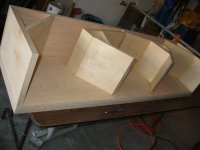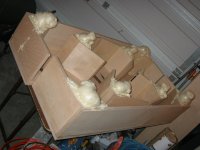I am looking for suggestions. I have some parts that are sitting on the shelf that were bought a while back with good intentions that have neglected. What I have is a pair of WR125s and a pair of Raven 1 tweeters. My previous experience with these Ravens is that they sound terrible if you try and use them too low, so enter the WR125. Should be a good match. Cross them over at 4-5k and life should be good. But what box should I build?
Should I buy another pair to make the Calhoun? Or would I be happy with the Bob? The MiniOnken is another option. I am just unsure of the strengths and weaknesses of my options.
Thanks.
DaveM
Should I buy another pair to make the Calhoun? Or would I be happy with the Bob? The MiniOnken is another option. I am just unsure of the strengths and weaknesses of my options.
Thanks.
DaveM
Scottmoose said:I reckon he might be OK Greg -a fair proportion of the series resistance is probably due to the lack of amp adjustment to Qt (I'm learning...). Most T-amps have a relatively low DF IIRC, so the T-amp's lack of voltage swinging ability might not be too much of a problem. I'm no expert though as you know, so please put me straight if I'm off the mark on this.
Greets!
Hmm, the driver is nominally 8 ohms, rising in the HF and if an 8 ohm series resistor is used, then the amp is always 'feeling' virtually a minimum of 16 ohms, rising in the HF, so if the amp's power supply isn't 'stiff' enough to provide sufficient voltage on demand..........
Bottom line, if the amp's not rated for 16 ohms, odds are it will 'lay down' big time on fast transients even though it's not being over driven based on its power rating. Remember, the amp's power supply is the most costly portion, so it's where the majority of cost management occurs.
I recently auditioned some Panasonic and Onkyo digital HT receivers that have gotten favorable reviews for their sonics, but when presented with 8 ohms series R with a nominally 8 ohm speaker they reminded me of a '50s AM transistor radio (no highs, no lows, must be @#$% kind of sound), so Caveat Emptor.
GM
Greets!
The 'problem' with the R1 is that it's brutally revealing, like a good compression loaded horn, so with its relatively high sensitivity, it needs a comparable bottom end. Mating it with a such a low sensitivity driver is a waste of nearly 10 dB of its ~12 dB distortion headroom, so unless these will be either nearfield monitors or listened to at typical TV viewing levels you may find them quite strident on some passages. I had the misfortune to be in a room when a small two way system using these were cranked up and it was akin to listening to aluminum being ripped. The same woofer cab with a Vifa? aluminum dome tweeter OTOH was a wonderful match.
WRT dual WR125s, this is fine if one is rolled off to account for any BSC, but 4-5 kHz is too high to run them in parallel IMO, especially if paired to the R1. Frankly, unless you plan to step up to a fairly large system using HE drivers at some point to match the R1s, maybe the best option is to sell them if you can get a fair price to fund the extra cost of components for one of the bipolar designs and add one of the small ribbons to add a bit of top end 'sparkle'/more off axis response if need be: http://www.planet10-hifi.com/boxes-CSS.html
GM
The 'problem' with the R1 is that it's brutally revealing, like a good compression loaded horn, so with its relatively high sensitivity, it needs a comparable bottom end. Mating it with a such a low sensitivity driver is a waste of nearly 10 dB of its ~12 dB distortion headroom, so unless these will be either nearfield monitors or listened to at typical TV viewing levels you may find them quite strident on some passages. I had the misfortune to be in a room when a small two way system using these were cranked up and it was akin to listening to aluminum being ripped. The same woofer cab with a Vifa? aluminum dome tweeter OTOH was a wonderful match.
WRT dual WR125s, this is fine if one is rolled off to account for any BSC, but 4-5 kHz is too high to run them in parallel IMO, especially if paired to the R1. Frankly, unless you plan to step up to a fairly large system using HE drivers at some point to match the R1s, maybe the best option is to sell them if you can get a fair price to fund the extra cost of components for one of the bipolar designs and add one of the small ribbons to add a bit of top end 'sparkle'/more off axis response if need be: http://www.planet10-hifi.com/boxes-CSS.html
GM
Newbie looking to build a Hiro..
A few quick questions from a new member:
1.) I have an opportunity to get a good pair of Fostex FE168 Sigma drivers for relatively cheap (note: not the newer FE186EZ version). Would this make a good candidate for the Hiro? Here are the specs for the older FE168:
FE168 specs
2.) This is going to be my first speaker build, but I am very comfortable with woodworking, and will have a full shop to use for the build process. Another question: wood choice. I noticed that some other speaker builders (including Cain speakers, which is actually based in Walla Walla, where I live) use woods other than birch. Would a choice such as maple be beneficial in the design, or should I just stick with voidless birch?
3.) Should I bother building a suprabaffle? I've seen this in many designs, is it worth adding?
4.) Should I consider a different amplifier? I have a Eico HF81 and a Sherwood s5000. Both seem like pretty good amplifiers, but I just want to make sure.
Any other general tips or comments are welcome, sorry for the brief hijack.
Chris
A few quick questions from a new member:
1.) I have an opportunity to get a good pair of Fostex FE168 Sigma drivers for relatively cheap (note: not the newer FE186EZ version). Would this make a good candidate for the Hiro? Here are the specs for the older FE168:
FE168 specs
2.) This is going to be my first speaker build, but I am very comfortable with woodworking, and will have a full shop to use for the build process. Another question: wood choice. I noticed that some other speaker builders (including Cain speakers, which is actually based in Walla Walla, where I live) use woods other than birch. Would a choice such as maple be beneficial in the design, or should I just stick with voidless birch?
3.) Should I bother building a suprabaffle? I've seen this in many designs, is it worth adding?
4.) Should I consider a different amplifier? I have a Eico HF81 and a Sherwood s5000. Both seem like pretty good amplifiers, but I just want to make sure.
Any other general tips or comments are welcome, sorry for the brief hijack.
Chris
I originally developed the suprabaffle ( name coined by Dave) to fill in the FR gap betwween the horn roll off and baffle action. A lot depends on the FR curve and the cab FR roll off. I am not knowing of the cab that you are refering to?
With the given Qts i would suggest a MLTL, it would require little electronic compensation.
ron
With the given Qts i would suggest a MLTL, it would require little electronic compensation.
ron
Well, the drivers I ended up with are Fostex fe166e's, so I would have to build the scaled down version of the Hiro. But, after looking at costs and options available, I think I'm just going to scratch a double horn design for now. Ron, I'm actually thinking of building one of your designs, the Austin 166. I will PM you so I wont continue the forum clutter....
ronc, can you send me an email? Since I'm a new member, I am not allowed to email other members yet......just shoot a message to cwujek@hotmail.com. Thanks,
Chris
Chris
cwujek said:the drivers I ended up with are Fostex fe166e's, so I would have to build the scaled down version of the Hiro.
Hiro was designed for the FE166e... as far as finesse goes, ron's are (likely) without peer.
dave
Re: Bruce V1.1
The driver position is not critical as far as the box is concerned.
With most of the output coming from the 208 i'd set it at listning level, and the supertweeter in the space leftover -- in the case of Bruce, probably underneath.
With the vertical symmetry of Bruce, you could actually try it both ways just by flipping the box over.
dave
albertli said:I'd like to know if I could place the 208ez driver a bit lower and so I could put the supertweeter right on top of that.
The driver position is not critical as far as the box is concerned.
With most of the output coming from the 208 i'd set it at listning level, and the supertweeter in the space leftover -- in the case of Bruce, probably underneath.
With the vertical symmetry of Bruce, you could actually try it both ways just by flipping the box over.
dave
- Home
- Loudspeakers
- Full Range
- Spawn of Frugel-Horn
 LOL!
LOL!

